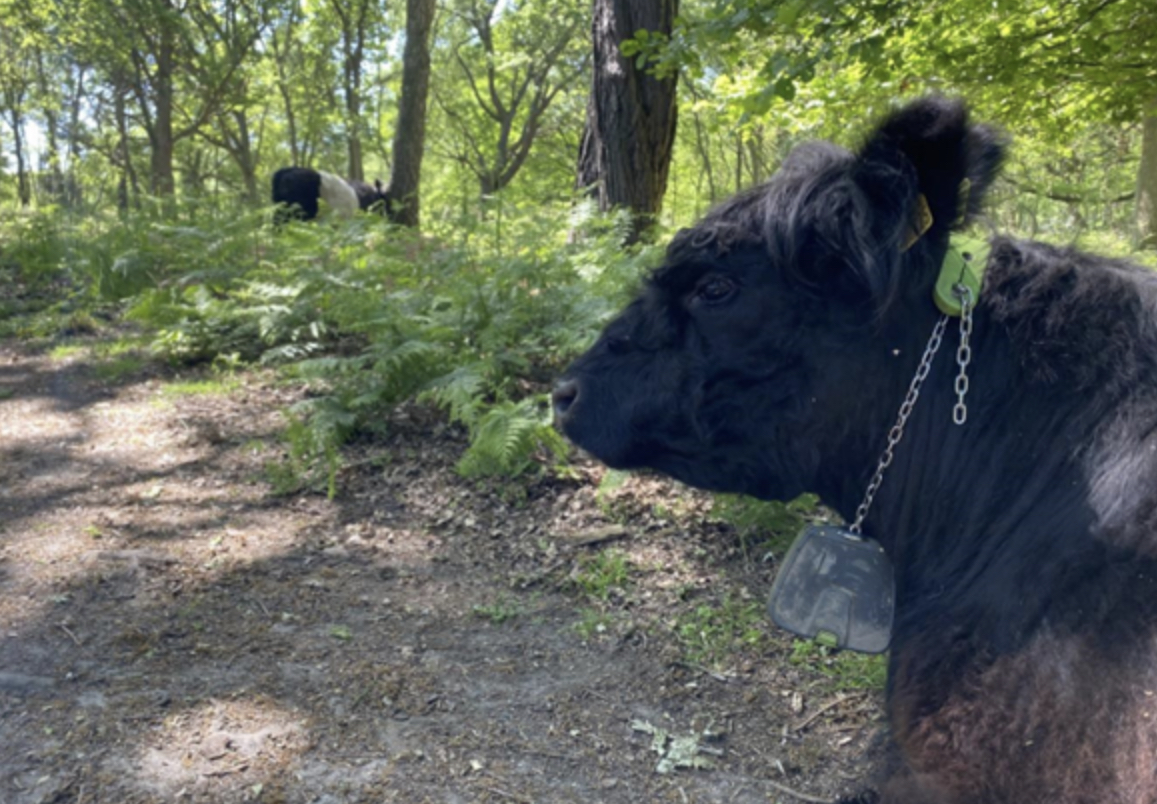 Abraham Lincoln
If given the truth, the people can be depended upon to meet any national crisis...
Abraham Lincoln
If given the truth, the people can be depended upon to meet any national crisis...
 Guildford news...
for Guildford people, brought to you by Guildford reporters - Guildford's own news service
Guildford news...
for Guildford people, brought to you by Guildford reporters - Guildford's own news service
GPS Grazing Collars for Moo-ving Surrey Cows
Published on: 25 Jul, 2023
Updated on: 27 Jul, 2023
Ground-breaking GPS technology is now being used on cattle across Surrey County Council’s countryside estate at Chobham, Wisley and Puttenham Commons to help with conservation grazing and benefit biodiversity.
‘Nofence’, is the world’s first virtual fencing for grazing cattle, helping to control where they graze without the need for traditional electric fencing. The new technology helps to better target exact grazing areas for ecological enhancements and saves time and money by not requiring the building, moving and maintenance of traditional fencing.
GPS collars are fitted to adult cattle and land managers map out virtual geographic boundaries of where cattle can go via an app. If cattle enter an area they are not allowed to go, the collar emits audio signals which increase in pitch until eventually a small electrical pulse is physically experienced.
The cattle quickly learn that increasing levels of sound mean they need to change their direction of travel. Land managers receive regular alerts to keep track of where each member of the herd is. Cattle collars are individual to each cow and charged using an inbuilt solar panel.
The new system, approved by veterinary professionals, has been successfully initiated by Surrey Wildlife Trust which undertakes the conservation management at Chobham and Wisley Commons and the Hampton Estate which owns Puttenham Common.
Marisa Heath, Surrey County Council Cabinet Member for Environment says: “We are delighted to be working in partnership with Surrey Wildlife Trust to make smart choices that make big differences to conservation.
“This technology works brilliantly on our large, open countryside sites, allowing us to successfully graze much wider areas of land. Not only does it save money but more importantly it hugely benefits biodiversity. At a time when nature is in global decline it is vital, we grab hold of new technologies like this to safeguard Surrey’s countryside for generations to come.”
Surrey Wildlife Trust Conservation Manager Adam Bolton says: “From training the animals and drawing up management plans to securing the backing of government agencies and other partners, the introduction of no-fence conservation grazing in Surrey has been a long but important journey for our team.
“It’s great to be working with Surrey County Council to help preserve the beauty and biodiversity of Chobham Common, and to pioneer a new phase in the conservation of this special site.”
Conservation grazing plays a vital part in managing Surrey’s countryside sites for wildlife and helps to promote biodiversity. It can be carried out on many types of land including woodland, scrub, wetlands and grassland. Grazing animals have shaped our landscapes for generations and are the most effective and sustainable way of maintaining habitats.
An example of how the new technology is already benefiting Surrey’s countryside can be seen at National Nature Reserve (NNR), Chobham Common which is home to rare heathland plant species, Marsh Gentian. This plant grows in wet, humid heath which is difficult to install stable fencing. Surrey Wildlife Trust can plot the plant location and install virtual barriers so cattle graze elsewhere, protecting the clusters of plants.
Other organisations such as the National Trust, RSPB, City of London council, and Yorkshire Wildlife Trust have all successfully trialled the new technology and continue to use it to benefit conservation at their sites.
Recent Articles
- Guildford Institute’s Crowdfunding Project for Accessible Toilet in its New Community and Wellbeing Centre
- Letter: Guildford – Another Opportunity Missed?
- Letter: GBC’s Corporate Strategy – Where Is the Ambition?
- My Memories of John Mayall at a Ground-breaking Gig in Guildford Nearly Six Decades Ago
- Westborough HMO Plans ‘Losing the Heart of the Street’ Says Resident
- College Invests to Boost Surrey’s Economy and Close Digital Skills Gap
- Community Lottery Brings Big Wins for Local Charities
- GBC Housing Plan Promises ‘A Vibrant Urban Neighbourhood’ Near Town Centre
- Hospital Pillows ‘Shortage’ at the Royal Surrey
- Updated: Caravans Set Up Camp at Ash Manor School


Search in Site
Media Gallery
Dragon Interview: Local Artist Leaves Her Mark At One of England’s Most Historic Buildings
January 21, 2023 / No Comment / Read MoreDragon Interview: Lib Dem Planning Chair: ‘Current Policy Doesn’t Work for Local People’
January 19, 2023 / No Comment / Read MoreA3 Tunnel in Guildford ‘Necessary’ for New Homes, Says Guildford’s MP
January 10, 2023 / No Comment / Read More‘Madness’ for London Road Scheme to Go Ahead Against ‘Huge Opposition’, Says SCC Leader
January 6, 2023 / No Comment / Read MoreCouncillor’s Son Starts Campaign for More Consultation on North Street Plan
December 30, 2022 / No Comment / Read MoreCounty Council Climbs Down Over London Road Works – Further ‘Engagement’ Period Announced
December 14, 2022 / No Comment / Read MoreDragon Interview: GBC Reaction to the Government’s Expected Decision to Relax Housing Targets
December 7, 2022 / No Comment / Read MoreHow Can Our Town Centre Businesses Recover? Watch the Shop Front Debate
May 18, 2020 / No Comment / Read More











Recent Comments